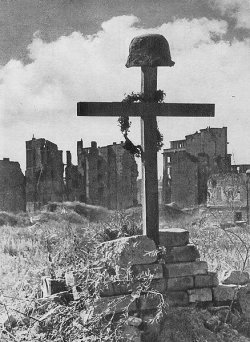
A lone insurgent cross on a battlefield in Czerniakow
Last Days of Czerniakow
Powisle Czerniakowskie (literally near-the-Vistula Czerniakow), which during the August uprising was known as Near Czerniakow and later on as Upper Czerniakow or Czerniakow, is rooted in the distant history of Warsaw. In the central part of Solec Street, there were one of the crossings through the Vistula River as well as a storehouse and a commercial harbour of salt, hence the name of the street (salt, in Polish sól - Solec). The area of Warsaw we are interested in - Powisle Czerniakowskie - encompasses the region between the overpass of the Poniatowski Bridge, in the north, Lazienkowska Street, in the south, and from the Vistula's embankment, in the west, to the bank of the Vistula, in the east.
From the mid-September to the date when the insurgency in this district collapsed, which is September 24, 1944, Near Czerniakow was the area of serious fighting. These fights are as much comparable to other battles of the Second World War which took place in a city and were of great importance, like the battle of Stalingrad or Berlin, as the defence of the insurgent Old Town of Warsaw.

A lone insurgent cross on a battlefield in Czerniakow
The Uprising in Czerniakow
At 17.00 hours, on August 1, 1944, in Czerniakow, just as in other districts of Warsaw, units of the Polish underground army moved into the open attack. Unfortunately, during the initial fights, the insurgents did not manage to take over the main buildings which were located in this area and garrisoned by the Germans. These buildings include the premises of the Sejm (the lower chamber of the Polish Parliament), the National Museum, the WKS Legia stadium and the German outpost situated at the western end of the Poniatowski Bridge. As a result of unsuccessful assaults, which were due to a certain mess, some units from Czerniakow withdrew to Kabaty Forest in the night of 1-2 of August, and other units retreated deeply to the initial positions. The area under control of the insurgents was delineated by Lazienkowska, Rozbrat, Szara and Czerniakowska Streets.
The crossing of the units of 3 DP of the General Berling's Polish First Army (1 AWP)
In the night of 7-8 of August, Captain "Kryska" - Zygmunt Netzer and 24th WSOP Company of "Narew" Battalion arrived at Czerniakow. The battalion took command of all the forces from that area and formed group V "Kryska". They reorganised subordinate forces and created "Tum" and "Tur" Battalions. In the nights of 3-4 and 4-5 of September, insurgent units of the "Radoslaw" Group, which were under Lieutenant-Colonel "Radoslaw's" (Jan Mazurkiewicz) command, were sent in two airdrops to Czerniakow. At that time, the reinforced group, together with other units, was estimated to consist of 500 to 600 soldiers who formed the battalions of "Broda" (former "Zoska" [Sophie] and "Parasol" [Umbrella] Battalions) and "Czata" (former "Czata 49" and "Miotla" [Broom] Battalions).
On September 7, Lieutenant-Colonel "Radoslaw" was appointed as a commander in Czerniakow and Captain "Kryska" was appointed the second in command. Another reorganisation took place. "Kryska" Group manned the south stretch of defence (from the Shipyard, through Lazienkowska and Rozbrat Streets to Szara Street). The defence in the north was assigned to "Radoslaw" Group (from Szara Street, through Rozbrat, Ksiazeca, Ludna and Solec Streets, to the bank of the Vistula). After the arrival of the units there was a relative peace in Czerniakow. For the soldiers who went through the hell of fighting in Wola as well as bombardments and shellfire in the Old Town , windowpanes in Czerniakow stirred a sensation and joy and were the proof that Warsaw is still alive.
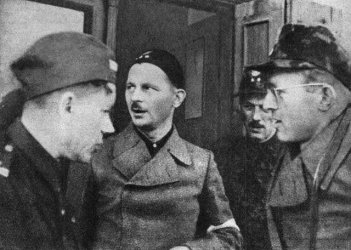
Lieutenant-Colonel - "Radoslaw", Jan Mazurkiewicz, (first from left) with his staff. Here, still in Wola.
In the first week or so of September, due to predictions about offensive military operations against Warsaw on the part of the Red Army, and in order to prevent that army's crossing through the Vistula, the Germans threw their main forces against the districts near the river which were under control of the insurgents. General von dem Bach (the commander of corps organised with the aim to fight against the insurgents) directed some 6 000 soldiers supported by tanks, assault guns and artillery to Czerniakow.
At that time the units of Colonel "Radoslaw" in Czerniakow included some 1100 soldiers and were supported by scarce supplies of ammunition. "Tur" and "Tum" Battalions were poorly armed too.
On September 10 serious fires from German heavy cannons and mortar fire accompanied by fierce aircraft bombarding began in Czerniakow. On the following day, enemy units equipped with armoured weapons, whose tasks were to oust the insurgents from their positions, to win subsequent streets, and to cut communications between Czerniakow and the city centre through Ksiazeca Street, attacked. The enemy's objective was also to drive Poles from the banks of the Vistula, hence the thrusts made along Solec Street.
On September 12, all impetus of the German machine of war in Warsaw was aimed at Powisle Czerniakowskie. From morning, the district was under fire from mortars and heavy rocket launchers (they were called "wardrobes" or "cows" by insurgents, because of the distinct sound they issued at the firing of missiles), as well as from heavy artillery, grenade launchers, and heavy machine guns. From the east, Poles were attacked by a gunboat floating on the Vistula. Bombing raids were not a rarity. During subsequent days, on account of the battle for Praga taking place at the other side of the river, the Germans tried to gain advantage during the offensive in Czerniakow, aiming to drive Polish soldiers from the riverbanks and to cut the communications with the city centre. The latter aim came into fruition only on September 13. The Germans succeeded to occupy strategic buildings on Na Skarpie Street - the diplomatic mission of China building and Pniewski's villa. They also entered St. Lazarus hospital.
However, they did not manage to drive the insurgents from the Vistula, which was a more important objective than cutting communications between Czerniakow and the city centre which ran through Ksiazeca Street. In Praga, the Germans, under the pressure from the Polish and Soviet armies, had to retreat to the left side of the Vistula and to blow up the bridges in Warsaw one by one on that day.
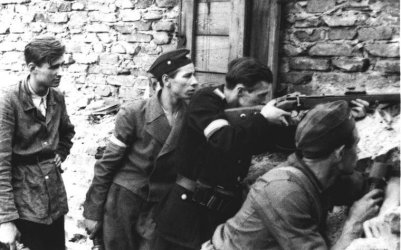
Warsaw insurgents on a barricade
In the night of 13-14 of September, the Soviet air forces airdropped food, weapons and ammunitions for the first time on the area of Czerniakow. The airdrops were made from Po-2 planes (called "terkotki" - clatters - by the insurgents) which, with engines switched-off and remaining at a low altitude, drove up over the designated area and dropped 50-kilo sacks and boxes which contained supplies and were devoid of parachutes.
On September 14, at around 4 p.m. Lieutenant-Colonel "Radoslaw" decided to keep the area near the Vistula and defend themselves in the weaker buildings of Solec and Czerniakowska Streets waiting for a landing and help from behind the Vistula River. He reorganised defensive forces by shrinking the defence line to Okragla Street along with the block of flats between Okragla and Solec Streets, Czerniakowska and Zagorna Streets. This meant that the insurgent forces moved away from the city centre. The defence of the riverbanks was assigned to Captain "Jerzy's" battalion. It consisted of the remainder of "Zoska" and "Parasol" Battalions, soldiers of which defended the access to Wilanowska Street from the side of Czerniakowska Street. The units of Captain "Motyl" [Butterfly] were to keep control over Okrag Street along with the institutions located at Ludna Street. The units of Major "Bicz" [Whip] - Edward Jaworowicz (a member of NSZ - National Armed Forces ), who took the command of the remainder of "Kryska" Group after wounded Lieutenant "Tum", were to keep control over Zagorna and Czerniakowska Streets.
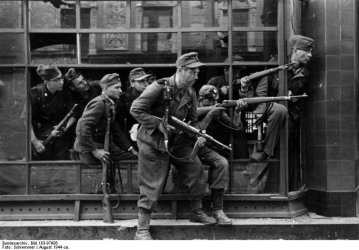
German soldiers from the SS Dirlewanger unit during the fighting in Warsaw.
That night "Zoska's" Company, under the command of Lieutenant "Morro", put under fire the banks of the Vistula and captured a half-sunken pleasure boat "Bajka" which was near the embankment. At dawn insurgents noticed 3 boats approaching Saska Kepa. That was the fifteen-strong 1 DP (1st Infantry Division) reconnaissance group. The landing force reached the left shore under German fire. Out of 15 soldiers, 11 made their way to Czerniakow, including 3 injured. Four of them died. While making an attempt to make contact with the landing forces, the members of "Zoska" Group thought they were dealing with the Russians. They were trying to get the landing soldiers to join them. Therefore, they were shouting in Russian and flourishing a white-and-red pennant.
At around 8 a.m. Lieutenant "Morro" went out to the newly-arrived and then, he was shot right in the heart. Lieutenant Andrzej Romocki "Morro" died probably as a result of an ill-fated accident, from a bullet fired by a Polish soldier who has come from over the Vistula River. Ex-soldiers from "Radoslaw" Group talked about the event in unofficial conversations. However, for propaganda reasons, this fact has not been publicised so far. "Morro" wore German army camouflage and a protective cover on a Polish helmet (wz.31); but a white-and-red band could have been out of eyeshot early in the morning.
After contact with Lieutenant-Colonel "Radoslaw" had been made, the reconnaissance group of 1DP returned on the right bank of the river. They took a liaison officer - Major Witold Sztampka "Kmita" -, who had a letter from Lieutenant-Colonel "Radoslaw" addressed "To the commander of Russian troops in Praga", with them.
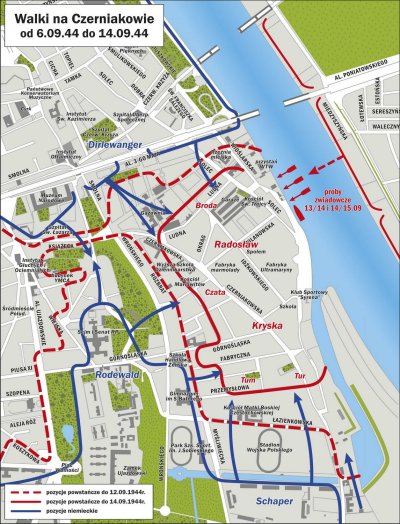
The fighting in Czerniakow September 6-14, 1944 (fig. Piotr Wawrzkiewicz)
After the safe crossing of Major "Kmita" who was accompanied by two insurgents (1 non-commissioned officer and 1private), the major was referred to the commander of 3rd Infantry Division - Brigadier Galicki, and then, to the commander of 1st army of WP (The Polish Armed Forces).
In the evening of September 15, the location of the two enemy sides was, in broad outline, as follows:
The insurgents were in control of the bridgehead:
- in the north, delineated by Okrag and Solec Streets; this sector was defended by the remainder of "Broda" [Beard] Battalion
- in the west, delineated by Czerniakowska Street; this sector was defended by the remainder of "Czata" Battalion
- in the south, delineated by Zagorna Street; this sector was defended by the remainder of "Kryska" Group
All in all, in Czerniakow there were about 500 soldiers who were extremely exhausted by fierce combat and who suffered from scarcity of ammunition. These forces were commanded by Lieutenant-Colonel "Radoslaw".
The enemy forces were located:
- from the north and partly from the northwest, in the area of 3 Maja Alley- the sub-units of strike forces Dirlewanger (which were a part of the General Reinefarth's battle group) consisting of 1968 soldiers
- from the west and the south, near the Sejm, Fabryczna Street, Sobieski's Park and Lower Mokotow - the sub-units of three sub-sectors (III,IV,V) whose activities were coordinated by the command of Colonel Schaper's regiment. The sub-sectors were a part of General Rohr's battle group. The number of these three sub-sectors reached around 3200 soldiers.
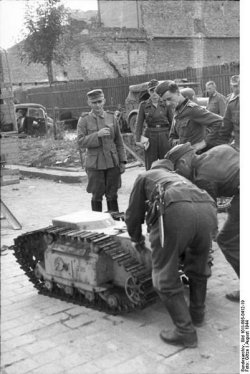
The Germans prepare "Goliat" for action
In the night of 15-16 of September (at around 4 a.m.) a reconnaissance group of 3 DP (60 people - 2 infantry platoons and an anti-tank platoon) made a landing in Czerniakow, after which they sent the signal - two white rockets indicating that "there is no enemy at the crossing point". At the signal, the crossing of 1st battalion (9pp - 9th infantry regiment, 3DP) which was under the command of Lieutenant Sergiusz Kononkow began. The crossing finished at 7 a.m.
In this way, on Saturday, September 16, 1944, the 47th day of the uprising, the soldiers of the General Zygmunt Berling's 1st army crossed the river and reached the left bank of the Vistula in Warsaw. At the same time, real help, which was awaited from the beginning of the uprising, arrived from the east to heroic insurgents .
The insurgents from Czerniakow were overcome by great joy and enthusiasm. There were new hopes that, after the forces have been joined, the insurgents and Berling's soldiers would be able to liberate Warsaw.
It could have seemed that the landing of 3 DP forces would cause some breakthrough in the fighting in Czerniakow. It was thought that the air space control over Warsaw, shellfire from across the Vistula and continuous, systematic, still increasing in number crossings to Czerniakow, which was occupied by the Home Army (AK), carried out by the refreshed forces of General Berling's army (members of which were called "berlingowcy" - Berling's people - by citizens of Warsaw) and the eventual liberation of the Polish capital is a matter of a few days. The plan designed by the staff of 1 AWP in September 16 assumed that the main forces of the army had to win the bridgehead in Warsaw, which was about 4 km deep and 5 km wide, within four nights and three days. This was supposed to lead to the joining of the forces to the insurgents from the city centre, Zoliborz and Mokotow. If only one could live according to the plans...
Whether it was due to the sluggishness of crossing activities, or due to purposeful actions of the Russians, the objectives of the plan were not fulfilled. It should be noticed at the beginning that, in accordance with the plan, all 1st army, together with 1 BPanc (2nd tank regiment) tanks, had to cross the river using 44 NLP semi-rafts (light rafts made of plywood, having the capacity of 25 soldiers) and 10 N2P rafts (heavy ones), 48 amphibians and basic means which were difficult to get. As can be seen, crossing time estimation and the calculation of the number of crossing means secured for action were very superficial and incorrect.
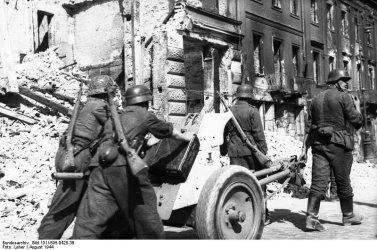
A German light cannon during the change of position
During the first night, two infantry companies, over one platoon of heavy machine guns (ckms) of 1st ckm company, over one platoon of armour-piercing rifles of the 1st armour-piercing rifles company, a part of 1st mortar company, a part of 45 mm-cannon platoon managed to cross the river. All in all, on the left bank of the river, including divisional scouts, there were 420 soldiers, 14 heavy machine guns, 16 armour piercing rifles, 6 50 mm grenade launchers, 3 82 mm mortars and a 45 mm cannon. Despite the insurgents' enthusiasm, these forces had no significant influence on the course of the battle in this region. There is no doubt they had won a few strategic points but the initiative remained in the Germans' hands. Moreover, it turned out that the soldiers from over the Vistula suffered great losses when it comes to dead, injured and lost men. "Berlingowcy" have never been trained to fight in a city. What is more, for most of them it was the first visit to such a big city as Warsaw.
There was no time to familiarise the soldiers with new fighting conditions, near the enemy, among the debris and charred ruins of the city, in the maze of secret passages in basements, under walls, between barricades.
Tadeusz Targoński, a soldier of 3rd battalion of 9 pp, recalled: "Our people try to dig trenches around their positions but here, cobbles and asphalt are everywhere. The insurgents laugh and are astounded that we cannot fight in a city as well as they can. (...) The boys from the east are getting lost in the occupied houses and are not able to move around efficiently. Initially, they are pacing around the rooms in a panic excitement because the enemy is everywhere, and it is difficult to find one's way here. The maze of rooms, staircases, basements and attics as well as extensions and top floor extensions are a novelty to people used to fight according to the military rules of the combat in the open."
During the second night (September 16/17) the crossing around the same point of the Vistula River was repeated. In the course of that night (by 5 a.m.) almost the whole 3rd battalion (without 2 platoons of 3rd mortar company) and the remnants of 1st battalion (first of all, 1st company) got across the river to the bridgehead. Numerically, the situation presents as follows: 390 people, 14 heavy machine guns, 16 armour-piercing rifles, 8 50 mm grenade launchers, 5 45 mm cannons. On that day in the south sector of the bridgehead Poles won a building located at Idzkowskiego 5/7 Street which cut into the insurgent unit. Unfortunately, it was still the enemy who had the advantage and who launched new attacks supported by tanks and assault activities. On that day, the Germans also gained the building of PKO (a retail bank) which was defended by the remainder of "Parasol".
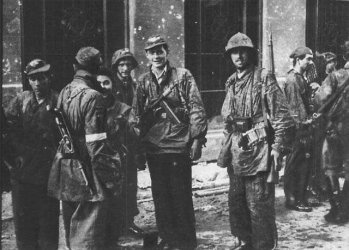
The soldiers of "Radoslaw" group after crossing the sewers from the Old Town to the city centre. A few days later, they moved to Czerniakow.
On September 17 soldiers repelled 11 German attacks which were supported by 10-12 tanks or assault guns. As a result of an overwhelming advantage of the Germans who became reinforced, Dirlewanger group was supplemented by 2 1000-strong battalions of 34 regiment belonging to Schultzpolizei, the defensive Polish forces were diminishing. The area of the bridgehead in control of the insurgents was shrinking and there was no real chance of any assistance from across the river.
The next crossing of 3 DP forces began only at about 3:30 a.m., September 18. This was because up to this point the Germans raked heavily the area where the crossings took place. They also lit up the Warsaw banks of the river and the river itself. During that night only 63 soldiers (the remainder of 3rd battalion and a part of 2nd battalion), 2 45 mm cannons, ammunition and food were redeployed to the bridgehead in Czerniakow. The Chief of Staff of 9 pp - Major Stanislaw Latyszonek - who took the command of all the forces of 9 pp situated in Czerniakow also reached the left bank of the river successfully.
Lieutenant Colonel "Radoslaw", a commander in the bridgehead, and Major Latyszonek asked the command of 3 DP through the radio to hasten the help arrival due to the loss of the front edge of the main position of defence and heavy losses in units. Lieutenant Colonel Radoslaw also reported that the rest of his group were going to defend the bridgehead only for 24 hours more.
On September 18 Warsaw was a witness to an unusual event. For many insurgents and civilians it was an experience of staggeringly joyful hope when between 2:50 and 3:15 p.m. American planes B-17 "Flying Fortress" flew over the town at an altitude of 3 000 metres. Initially, everybody thought it was an airdrop of 1st Parachute Brigade awaited from the beginning of the uprising. However, when it turned out that containers carrying supplies fell on the terrain occupied by the Germans, all the joy and enthusiasm waned.
In the following night a crossing to Czerniakow hardly took place. The army from across the Vistula was planning to cross the river at a different place. On September 19, at around 4 p.m. the crossing of 8 pp of 3 DP forces to the area between the Srednicowy and Poniatowski Bridges (which was to the north of the bridgehead in Czerniakow) began. They managed to get about 1000 soldiers across the river but the enemy threw reserves into battle immediately. Before midnight only isolated groups of soldiers deprived of any command and contact with the right bank were fighting between the bridges within the bridgehead.
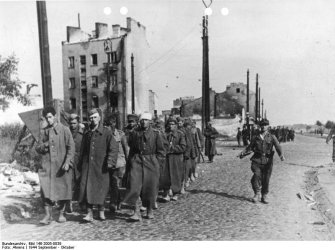
The prisoners-of-war - the soldiers of General Berling's 1 AWP
In the late evening, September 19, due to the lack of further assistance from across the Vistula, Lieutenant- Colonel "Radoslaw" and Major Latyszonek agreed that it was impossible to hold the bridgehead having such poor forces and means at their disposal. It was decided that they withdrew gradually from the waterfront. The insurgents of "Radoslaw" had to leave through sewers to Mokotow; the soldiers of Latyszonek together with the injured were supposed to be carried by boats to Praga. At around midnight Lieutenant-Colonel "Radoslaw" together with a group of some 260 insurgents got through a manhole situated at the corner of Zagorna Street into a sewer and got to Mokotow.
On a small patch of land in Upper Czerniakow, between Wilanowska, Idzkowskiego and Zagorna Street, a group of insurgents from "Zoska" and "Parasol" (about 90 people) under Captain "Jerzy's" command stayed behind in order to defend the injured until they were evacuated to Praga. Moreover, in Czerniakow there was still a group of about 70 insurgents from other units who probably did not get the order to evacuate themselves through sewers. At the same time about 700 soldiers of 9 pp under mjr Latyszonek's command remained in Czerniakow in anticipation of the promised evacuation.
It seems that September 18 and 19 were crucial for the further existence of the bridgehead in Czerniakow. The hope for successful crossings in Czerniakow zone as well as operations and assistance from 8 pp failed. Some of the insurgents and their commander evacuated through sewers. Owing to the failure of the operation on the left bank of the Vistula, probably on September 20, the HQ of 1 AWP made the decision to stop the crossings through the Vistula River in the direction of Warsaw. In accordance with this decision, only limited reconnaissance and escape trials across the river in the direction of Czerniakow should be undertaken.
The last days in Czerniakowskie Powisle
The subsequent days in Czerniakow are replete with episodes of unprecedented heroism on the part of the insurgents and bestiality performed by the Germans and soldiers of other nationalities collaborating with them. Examples could be multiplied and these are a few of them.
Warrant Officer Kunysz directed shellfire at the house at 6 Zagorna Street which was occupied by spotters of 3pal (light artillery regiment) and there he found his death. However, before he died he managed to bury many attacking enemies. In the hall of "Spolem", after capturing many insurgents, civilians and soldiers of 3 DP, the Germans sought out young men from among civilians and executed them together with the insurgents on the spot.
Adam Borkiewicz: "A few girls suffered the same fate. There was one of the bravest women of the uprising among them. That was a liaison officer "Szympans" [Chimpanzee] (Maria Celtys). She was not saved by the fact that her arm was amputated a month before. When she was asked the question: 'Bist du Banditin?' she answered proudly: 'I am a soldier of the Home Army (AK)', for which she was killed at once."
In the building at 5 Wilanowska Street the Germans murdered 122 people, 12 by hanging. Members of "Parasol" battalion, "dr Turek", Sultan Safijew, and "Pawel", Peter Forro (they were Jews from "Gesiowka" who were liberated previously: "dr Turek" - a citizen of the USRR of Turkish origin, "Pawel" from Hungary), died when they were sent as peace envoys on behalf of a group surrounded in a small house located on the premises of "Spolem" storehouses. Without any attempt to start negotiations, the Germans murdered both insurgents.
September 21 passed slowly on constant fighting. In the evening, the area defended by Poles shrank to around 250 m of shore and two buildings: 53 Solec Street and 1 Wilanowska Street. The last house at the corner of Solec and Wilanowska Streets (1 Wilanowska Street) constituted something of a citadel for this little stronghold. The building was occupied by the defenders: the unit of armour-piercing rifles of 9 pp, the unit under Captain "Jerzy's" command (80 insurgents). There, in the basement, the headquarters were situated: Major Latyszonek and Captain "Jerzy" with radio station which due to the lack of batteries was out of use. In other rooms seriously injured men, who were stepped on by soldiers hurrying to their posts, lay.
The estate at 53 Solec Street was garrisoned by the insurgent unit ("Kryska" group, 6th company) which was under Lieutenant-Colonel "Szumski's" (Stanislaw Jordan-Warzycki) command and which consisted of 60 soldiers, including 7 women. The buildings were, in a way, linked by 9th regiment lying in trenches. The front part of the house at 52 Solec Street was burnt. The defenders garrisoned outbuildings, and the basement gave shelter to civilians. At the rear of that house there were deserted garages whose wing adjoined the backyard of the estate at 1 Wilanowska Street. The Polish forces, defending themselves on the area of less than 3000 m2 and consisting of 620 soldiers of 9 pp and 140 insurgents, experienced extreme exhaustion due to overall tiredness, lack of sleep, hunger and thirst.
In the night of 21-22 of September only a few boats bringing a bit of bread and taking some of the injured came from Saska Kepa. Some of civilians, who under fire waited for salutary boats on the banks of the river all night long, were evacuated as well.
During the night, having gathered the reserves of torch batteries, the dead batteries of the single operating radio station were charged up and early in the morning the contact with Praga was re-established. The commanders - Major Latyszonek and Captain "Jerzy" - reached an agreement with the command of 3 DP and arranged the plan for evacuation: at 8 a.m. 100 rafts were to arrive and take all soldiers, the injured and civilians. At the same time, the Germans sent peace envoys with the proposal to surrender. Captain "Jerzy" accepted only one-hour truce in order to enable for the main part civilians to break out of the encirclement.
As soon as the time of the truce passed, at 9 a.m., the Germans attacked from the side of garages towards the building at 1 Wilanowska Street where, fortunately, they were repelled. However, before they withdrew, they managed to set fire to the garages (which were dowsed with petrol during the truce). The fire spread to the 1st floor of the building. The enemy, supported by 3 tanks, launched an offensive from three directions against the defenders struggling with fire. At the same time the unit under Second Lieutenant "Szumski's" command defending the house at 53 Solec Street was attacked by the Germans. In the south sector of Polish defence disorganisation caused by the capitulation of some of the soldiers took place. Counter-attack from 1 Wilanowska Street led by Captain "Jerzy" and successfully supported by fire from across the Vistula came to Second Lieutenant "Szumski's" group's rescue.
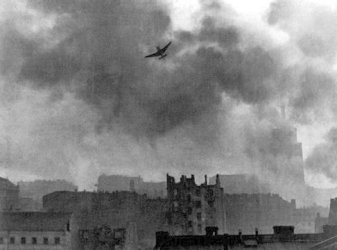
A German Ju-87 Stuka dive-bomber after dropping a bomb over Warsaw
However, the last battle for Czerniakow was dying down. During the day time the radio station broadcast that the crossing which was previously planned had been postponed to 8 p.m. Another postponement broke resistance of the majority of soldiers and insurgents. German attacks, so far repelled fiercely by the outpost at 1 Wilanowska Street, were advancing deeper into Polish line in Solec where the enemy took a considerable number of prisoners-of-war. Until the evening two buildings were in Polish hands: one at 53 Solec Street where, together with the injured and women, there were about 30 insurgents with Second Lieutenant "Szumski" and another one at 1Wilanowska Street garrisoned by some 100 people under Captain "Jerzy's" command. The remained units were disintegrated and disorganised. Soldiers and insurgents often attempted to rescue themselves on their own or turned themselves in to the Germans.
At around 7 p.m. the news about another postponement of the crossing came; this time it was to take place at 9 p.m. At around 9 p.m. Second Lieutenant "Slon" [Elephant] (Jerzy Gawin, "Zoska" Battalion) covered the crossing place. He stood there with a torch and a green light showing where the boats from Saska Kepa should draw up. For the umpteenth time the injured were gathered at the ship "Bajka" and in its vicinity making preparations for evacuation. The rest of 9th regiment, around 200 soldiers, were also gathered there. Ultimately, instead of 100 boats previously promised, only a few came from Saska Kepa. On that night 94 people (40 soldiers of 9 pp), including 15 women and children, were evacuated.
Although the soldiers attending the boats insisted commanders should have been evacuated first, Captain "Jerzy" and Major Latyszonek decided to leave the shore together with their subordinates. A sapper officer who got to the bridgehead also informed that because of the losses the crossing were going to continue gradually. Every night 15 boats were to arrive. This information very negatively influenced the rest of troubled soldiers. Some of them became apathetic and were incapable of any actions, some of them made attempts to save themselves by swimming across the Vistula or on makeshift rafts. In the bridgehead there were still some100 soldiers of 9 pp with Major Latyszonek and several officers, around 70 insurgents with Captain "Jerzy" and several dozen of the injured. Moreover, in the part of the building at 53 Solec Street there was around 30 insurgents with Second Lieutenant "Szumski" who were incapable of fighting. In the face of the information about sending 15 boats nightly, which Captain "Jerzy" received at around 2:30 a.m., the insurgent commander decided to fight his way to the city centre together with the remainder of his unit. On approving this decision, Major Latyszonek, with a group of his 20 soldiers, joined the insurgents. Additionally, in order to inform the other side of the river so that the injured (who were left on the ship "Bajka" and on the shore) could have been evacuated and more boats were sent, Captain "Jerzy" sent three insurgents who voluntarily swam across the river.
The meeting of a unit expected to fight its way to the city centre took place in a courtyard of a house at 51/53 Solec Street. "Ojciec Pawel" [Father Paul] (Jozef Warszawski - a chaplain of "Radoslaw" group) absolved everyone and told a few encouraging words. Before they set off, Captain "Jerzy" gave explanations concerning the pre-planned route: Wilanowska and Czerniakowska Street, then along Czerniakowska Street towards the building of ZUS (Social Insurance Institution), near ZUS, upwards the scarp to Frascati Street and from there towards YMCA (Young Men's Christian Association) or the Deaf Institute; the buildings which were probably garrisoned by the insurgents from the city centre. The order of groups was established: the advance guard was supposed to be armed with sub-machine guns and grenades and included Second Lieutenant "Slon", officer cadet "Sep" [Vulture] (Wojciech Markowski) and officer cadet "Halicz" (Henryk Konczykowski) as well as Captain "Jerzy" as the commander of the action and "Ojciec Pawel" as a guide. Following the advance guard, at some distance, in order to ensure contact between the advance guard and the main group, a liaison officer "Wika" (Maria Calka), just behind her, also at some distance, the main group including Major Latyszonek's soldiers (about 80-100 people), went.
After heaving left the ruins and having reached Solec Street, the unit got to no-man's-land. The advance group came across communication trenches and while going along them they entered a German outpost by chance. Having got into fight too early, the soldiers of the advance group bombarded the Germans with grenades. The Germans counter-attacked by firing machine guns. In that combat, Second Lieutenant "Slon" leading the unit lost his life. In the ensuing shooting and turmoil the groups lost contact with each other. A part of the disorientated main group dispersed and the other part, including Major Latyszonek and "Ojciec Pawel" withdrew. Seeking out and gathering the main group brought no results. Summoning the others was left without any answer. A group of insurgents with Captain "Jerzy" and "Berlingowcy" squad with a sergeant continued the journey. Finally, having experienced many adventures, pretending a German patrol among others, 5 people, "Jerzy", "Halicz", "Blad", "Wika" and the sergeant of 9 pp, managed to get to Polish outpost in the city centre.
"Ojciec Pawel" made an attempt to organise the rest of the group and to continue making their way to the city centre. However, because some people did not believe in success, he surrendered the leadership. Ultimately, "Ojciec Pawel" decided to move towards the ZUS building at dawn and to capitulate there. A group of insurgents (2 men and 5 women) objected and on following night (September 23/24), on their own account, they sneaked to Ksiazeca Street, which was manned by the insurgents from the city centre, with the loss of two people. In the meantime, the soldiers of 1 AWP from "Ojciec Pawel's" group used the hand signals to communicate the Germans that they want to surrender. In such a situation, "Ojciec Pawel" - Jozef Warszawski - decided to go to enemy positions as a peace envoy.
The Germans accepted the capitulation of the unit and gave the capitulators 15 min. to come out. The unit of the insurgents and the soldiers of 9 pp as well as civilians bunched up behind Major Latyszonek and "Ojciec Pawel". The Germans surrounded the group and began a body search. They were enraged when they discovered that one of girls had a gun. The girl was hanged, the rest of people were beaten and, initially, intended to be executed. A German officer opposed to that. He stopped the execution claiming that the Germans are not barbarians.
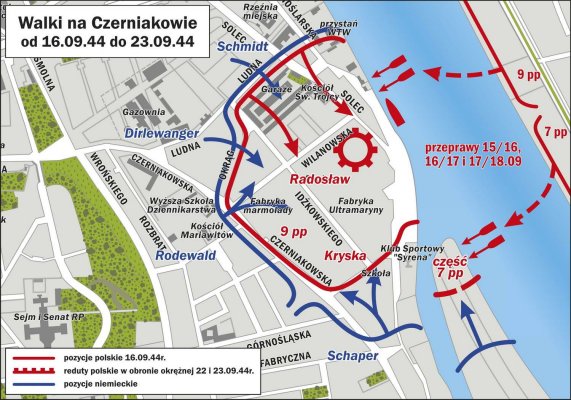
Battles in Czerniakow, September 6-14, 1944 (fig. Piotr Wawrzkiewicz)
At around 6 a.m., on September 23, 1944, the Germans began to carefully garrison the insurgent battlefield where there was no resistance. Several SS-men went to basements and murdered all injured men who were not able to go out on their own. Civilians, there were a few disguised insurgents among them, were gathered separately, formed a column, were given escort and finally, were led to the West railway station. The insurgents and the soldiers of 9 pp were taken prisoners.
Life of the capitulating soldiers of the Home Army (AK) often depended on a German unit, in hands of which they found themselves. The criminals of Dirlewanger and the Germans from other SS units garrisoned the insurgent outpost which was in the building at 53 Solec Street and which, after Captain "Jerzy" has left the building at 1 Wilanowska Street, was the last one that was manned in the bridgehead. At 6 a.m. German soldiers approached the building and garages. From among 30-something already defenceless group only Second Lieutenant "Szumski" managed to change his clothes for civilian ones. An SS-man who carried out a search found a photo taken during the uprising in his wallet. Having got enraged, he fired short burst in Second Lieutenant "Szumski's" stomach.
A priest "Rudy" [Ginger], Jozef Stanek (a chaplain of "Zoska" group), was hanged with his own scarf by the Germans. Another version of that event says that it was his stole. Five other seriously injured insurgents were hanged too. 15 insurgents and 5 girls from the group occupying the building at 53 Solec Street were murdered by the Germans - the men were shot and the girls were hanged. In Solec, near the statue of The Mermaid, the Nazis hanged around 30 insurgents. While penetrating the basements and ruins that were previously occupied, the Germans pulled out the dead bodies of the insurgents and civilians. Only in front of 1 Wilanowska Street and "Spolem" there were stacks formed out of 400 corpses.
On September 23, a German report of intelligence services said: (Kwiatkowski Maciej Jozef) "In the encirclement south to Nowy Most (New Bridge), after fierce battle, the resistance of the enemy was broken, the encirclement cleared, including the closing of the gap at the banks of the Vistula. The enemy suffered great losses. Taken prisoners: 82 Polish legionaries, 57 bandits, 30 armed women. Captured: 3 anti-tank guns, calibre 4,5; 2 heavy machine guns, 1 nkm (multi-calibre machine gun), 12 light machine guns, 15 sub-machine guns, 1 armour-piercing rifle, 16 automatic rifles, 37 rifles, 3 light grenade launchers, 2 portable radio stations and another 6 portable radio-stations and a great number of mpi (machine pistols) and guns unfit for further use".
In the night of 23-24 of September around 50 people were evacuated to the eastern shore from Czerniakow.
The ship "Bajka" [Fairytale]
The ship "Bajka" was a pleasure boat functioning as both a jetty and a café. Moored at the port in Czerniakow, it was raked by the Germans on September 12. The ship leaned to port side and ran aground. In the last days of fighting in Czerniakow, the insurgents brought there injured men preparing them for the evacuation to the other side of the river which was promised before. And although in his book "Powisle Czerniakowskie 1944" Tadeusz Grigo states that it was the evening of September 23 when the Germans, after bombarding the half-sunken boat with grenades, entered "Bajka" and took the insurgents away, "Czart" (S. Lechmirowicz) from "Zoska" and "Cesiek-Lalka's" [Cesiek-Doll] (Cz. Zaborowski) from "Miotla" accounts provide different information.
According to these accounts a group of injured insurgents and soldiers of 9 pp remained jammed on the board of "Bajka" and near the shore still after September 23. Some of them tried to save themselves by making their way through bridge spans of the blown-up the Poniatowski Bridge.
Stanislaw Lechmirowicz "Czart" from "Zoska" recollects: "And here's the third pier of the bridge, and a stile in it, similar to that in the previous one. I penetrate its dark interior and look down. Underneath, two floors beneath, a pulled-down roadway lies. A smooth, steep wall, water at the bottom - that's it. Healthy men maybe could lower themselves down a group of cables dangling around a metre on the left of the hole, but we? Should we return? No, we won't manage. On the right of the hole there is a recess. We sit there for a long time, a hopelessly long time... Wiktor leaves. I sit there alone, I lose all track of time. Suddenly, from below, a muffled voice of Wiktor reaches my ears. I get up frantically and I approach the hole. Down there, water pushing through a crack near a pier bubbles. On a pulled-down bridge span stands Wiktor. You see, you see!
I lean out of the hole breathlessly, I get hold of the cables with my healthy hand and I lower myself. I try to support myself with my healthy hand and leg, but in vain. Clothes covering my stomach are being torn to shreds, which injures my body. I cannot withstand the pain, I spread my fingers... but my legs surprisingly find a foothold. Weary and bruised, we lie down on wooden paving blocks and have a rest. Night fell already. Warsaw is burning behind us. I bite my lips out of pain and summon up all my strength. I am dizzy, I lose all sense of direction and hope that I will be able to continue the journey. (...) With vacant eyes we catch the shape of iron, with weak hands we get hold of its cold edges and flounder further... forward! My head is spinning, my ears are ringing. Our faces are distorted by incredible pain and our eyes gaze hopelessly at obstacles which materialise out of nowhere. A shapeless thought keeps going in my feverish head. Some piers lacking in spans, among which there is dark smooth water surface, come into sight as a figment of my feverish imagination, as if they were a ghastly phantom. Leaning helplessly on a breach in the surface I look downward: empty and devoid of rails precipice separates us from the pier. Terrified eyes look for help. The body, already inert, slips somewhere into deep and touches water. But, what is this? The water surface is covered with wrecks which form something like an artificial jetty. Good God! There is hope! As we were in a frenzy, we enter the boats which are dotted with bullets and filled with sacks and ammunition as if we were in a frenzy. Only meters separate us from the shore. We pass corpses squeezed between the remains of canoes and we come ashore. With the last reserves of energy Wiktor and I embrace each other and we slump powerlessly on gravel. Far away, on the other side, plays the heavy machine gun, and in front of us, glides a light ribbon of a rocket... The weary eye catches a flash of a bayonet emerging from behind a pier. Who is there? - I n s u r g e n t s..."
That is how Stanislaw Lechmirowicz "Czart" and Bogdan Celinski 'Wiktor", soldiers of "Zoska", get to the other side of the river.
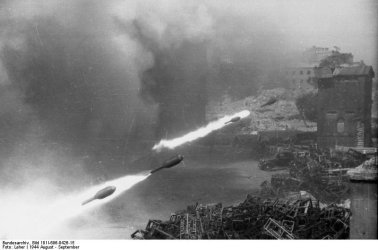
A German picture depicting the firing rocket missiles from heavy launchers - Schweres Wurfgestell - 28-32 cm of calibre. This weapon was named "szafa" - 'a wardrobe', in the city centre, or "krowa" - 'a cow', in the Old Town by insurgents due to a distinct sound (grinding, whining) accompanying the firing of missiles.
In the last days of fighting in Powisle Czerniakowskie many insurgents and soldiers of 9 pp from already scattered and disorganised units made attempts to swim across the Vistula.
Juliusz Deczkowski "Laudanski" ("Zoska" Battalion) recollects: "I pushed off the board of the ship "Bajka" strongly. I felt the nice cool of water. I could drink with no limits then. Only when I realized that drowned bodies were lying there for a few days, the water started to taste differently. Every move of my arms, every push of my legs made me closer to Saska Kepa. (...) I felt that not only did I lose my strength, but I was also not sure of my first decision. I decided to touch the bottom. I was glad as the river in that place was about a metre deep. (...) I looked back and, from a greater perspective, I saw the blazing city. I was out of my depth again, but the shore was near. Only several dozen metres of swimming and crawling in still shallower water. When I tried to raise myself, I felt numb, stiffening arms and legs. The whole body became strangely heavy."
Apart from "Laudanski" other people including e.g.: Janina Borowska-Szczesna "Jeanette" ("Parasol" Battalion), Tadeusz Targonski (III/9 pp 3 DP), Tadeusz Sosinski (III/9 pp 3 DP) Stanislaw Krupa "Nita" ("Zoska"), Henryk Deminet "Mis" ("Zoska"), Tadeusz Hoffman "Kruk" ("Kryska" group), Stanislaw Komornicki "Nalecz" (104th company, "Tum" Battalion in Czerniakow) swam across the river successfully.
On the ship "Bajka" the injured soldiers from 9pp, the Home Army (AK) and other scattered units were left. They were took prisoners only on October 2, 1944.
Czeslaw Zaborowski "Cesiek-Lalka" from "Miotla" Battalion recollects the last days in Czerniakow as follows: "There were around 10 of us when we got to "Bajka". People try to reach Praga using anything they had at their disposal. The Germans squeezed bursts from grenade launchers in the direction of the Vistula, it was a rain of grenades, an explosion occurred every second and fountain went upwards. It was getting brighter, "Blyskawica" [Lightning] and I grabbed a pillar and we began swimming. The rain of grenades was coming from the turrets of the Poniatowski overpass. Fire from machine guns. Our legs were seized with cramps. We got back. The pillar carried me to "Bajka" somehow, and if "Berlingowcy" had not pulled me out, I would have been drowned for sure. I did not find neither clothes nor shoes. We had to undress the dead, and having worn a military coat I found a place on a rudder blade. I mean, we laid down planks and we could have had a rest while sitting. On the board there were injured men. They were groaning. A horrible sight."
According to Czeslaw Zaborowski on the board of the ship there were about 50-60 people at that time, among others Second Lieutenant berlingowiec who, due to the fact that he held the highest rank, was in command. There were also broken-down radio stations and a host of weapons and ammunition. The dead men were removed into water. Food was obtained somewhere in Zagorna Street and there was plenty of drinking water in the Vistula. It was better, however, if it was drawn in front of "Bajka". In the evening of September 26 a canoe with a warrant officer, a sergeant and a sapper pulled in to "Bajka". They came to take Major Latyszonek; their orders were to bring him to Praga dead or alive. Nobody knew what happened to him. The last time he was seen was at 1Wilanowska Street. The soldiers who arrived to take him went in search of him but they did not come back. In the 3 subsequent nights a boat pulled in to "Bajka" taking 2 injured men. Every time arrivals inquired after berlingowcy and Major Latyszonek.
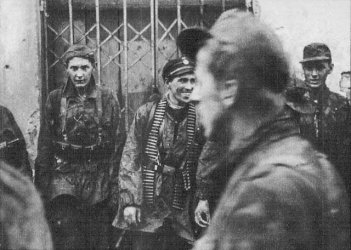
The soldiers of "Radoslaw" Group
Czeslaw Zaborowski continues: "It was on October 2 and it was already dark. Three civilians with their hands up came to "Bajka". The man who was on duty stopped them and brought them to the Second Lieutenant who was treated as our commander. They said they are Poles working for the Germans as grave- and fortification diggers, and they were sent by the Germans so that we surrendered because in half an hour "Bajka" would be blown up, and that it would be absolutely meaningless, that the whole Warsaw had already surrendered, that we would be treated properly, that "Bajka" is surrounded. The Second Lieutenant organised a briefing, no one, however, wanted to take the floor. Only a few of elders said that in such a situation an attempt to defend ourselves was aimless and we ought to surrender. No one tried to protest. (...) We removed the radio stations, weapons and ammunition into water at once. It made a big splash. The Vistula accepted the load. The same Vistula, which separated us from freedom. (...) One of the civilians remained on "Bajka", the other two returned to the Germans. We waited for a good quarter. Some of us hid watches and wedding rings in shoes, so did I. The two civilians and perhaps 4 Germans (they had Harman Göring Division bands on their arms) arrived and other Germans stopped at top of the riverbank. Germans who entered "Bajka" ordered us to head for a street one by one."
compiled by Szymon Nowak
edited by Maciej Janaszek-Seydlitz
translated by Sabina Decowska
Bibliography:
1. Baczko Henryk , 8 dni na lewym brzegu, Warszawa 1946;
2. Białous Ryszard "Jerzy", Walka w pożodze, Warszawa 2000;
3. Borkiewicz Adam, Powstanie Warszawskie. 1944. Zarys działań natury wojskowej, Warszawa 1964;
4. Deczkowski Juliusz Bogdan "Laudański"Wspomnienia żołnierza baonu AK "Zo¶ka", Warszawa 2004
5. Grigo Tadeusz . Powi¶le Czerniakowskie 1944, Warszawa 1989;
6. Kwiatkowski Maciej Józef, Tu mówi powstańcza Warszawa... Dni Powstania w audycjach Polskiego Radia i dokumentach niemieckich, Warszawa 1994;
7. Margules Józef , Przyczółki Warszawskie, Warszawa 1962;
8. Mórawski Karol, ¦wierczek Lidia , Czerniaków. Warszawskie Termopile 1944, Warszawa 2001;
9. "Pamiętniki żołnierzy baonu Zo¶ka", Warszawa 1986;
10. Sawicki Tadeusz , Rozkaz: zdławić powstanie. Siły zbrojne III Rzeszy w walce z Powstaniem Warszawskim 1944, Warszawa 2001;
11. Targoński Tadeusz , Kresowiak na Czerniakowie, "Gazeta Wyborcza Stołeczna", 21 wrze¶nia 2004;
12. Targoński Tadeusz , Wspomnienia, maszynopis i rękopis w posiadaniu autora;
13. Zaborowski Czeslaw , Przyczółek czerniakowski, Biuletyn Stowarzyszenie - Klub Kawalerów Orderu Wojennego Virtuti Militari, Warszawa, Lipiec-wrzesień 2005;
14. Zaborowski Czesław Wspomnienia rękopis w posiadaniu autora.
Attention! The most of the text is to be found in the issue 1(40)/2011 of "Militaria XX w." magazine.
Copyright © 2011 SPPW1944. All rights reserved.